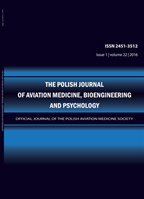2017, Volume 23, Issue 2
HEMODYNAMIC PARAMETERS AND BRAIN OXYGENATION IN MILITARY PILOTS AS A FUNCTION OF ACCELERATION’S DURATION AT 4G AND AT 6G: A PRELIMINARY STUDY
Krzysztof KOWALCZUK1, Liana PUCHALSKA2, Hanna PALONEK3, Aleksander SOBOTNICKI4, Michał JANEWICZ1, Mariusz WYLEŻOŁ5, Stefan P. GAŹDZIŃSKI6
-------------------------------------------------------------------------------------------------
1Department of Simulator Studies and Aeromedical Training, Military Institute of Aviation Medicine
2Warsaw Medical University
3University of Mining and Technology
4Research Institute of Medical Technology
5Department of Surgery, Military Institute of Aviation Medicine
6Creative Neuroscience Lab – CNS Lab, Military Institute of Aviation Medicine
Autor korenspondencyjny: Krzysztof KOWALCZUK; Department of Simulator Studies and Aeromedical Training, Military Institute of Aviation Medicine; email: kkowalczuk@wiml.waw.pl
Full text
Streszczenie
Introduction: Rapid onset and prolonged/sustained accelerations are often encountered in military aviation. The centrifugal force causes blood mass volume displacements. The pilot counters this phenomenon by means of anti-G straining manoeuvres (AGSM). However, the physiology of such prolonged manoeuvres is not clear. Here we have evaluated the effects of 4G and 6G accelerations lasting 10s from 1.41Gz baseline on stroke volume (SV) and cardiac output (CO) and data quality, as well as changes in frontal brain oxygenation (OX) as a function of duration of the acceleration. We further compared the pilots’ physiological responses to 4G and 6G.
Method: Ten military pilots (six active, with various amount of flight experience) performed the rapid onset rate (ROR) profile characterized by rapid onsets of Gz to 4G and 6G that 6 lasted for 10 seconds, each without Anti-G trousers. The pilots’ SV, CO were evaluated with bioimpedance cardiography, while their OX - with near infrared spectroscopy. ECG was constantly monitored.
Results: SV and CO were generally decreasing with time, whereas HR was increasing. On average, SV was not different between 4G and 6G. However, CO and HR were significantly higher at 4G than at baseline (p<0.02), as well as they were higher at 6G than at 4G and baseline (p<0.005). Despite that OX on average was lower at 6G than at 4G than at baseline (p<0.03). The data was of poorer quality and less of them were included in the numerical analyses for 6G than for 4G, most likely due to the performed AGSM.
Discussion: Rapid onset acceleration leads to physiological adaptations that are more pronounced at 6G than at 4G. There is some variability in the results due to the use of AGSM, which has a degrading effect on data quality.
Słowa kluczowe
hemodynamics, bioimpedance cardiography, +Gz, monitoring, brain oxygenation
